Buddha's Birthday
Buddha's birthday is a Buddhist festival that is celebrated in most of East Asia commemorating the birth of the Prince Siddhartha Gautama, later the Gautama Buddha, who was the founder of Buddhism. According to Buddhist tradition and modern academic consensus, Gautama Buddha was born c. 563–483 BCE in Lumbini (currently located in Nepal), and raised in the Shakya capital of Kapilavastu.[2][3]
| Buddha's Birthday | |
|---|---|
.jpg) Buddha's Birthday celebration in Seoul, South Korea | |
| Official name | Fódàn (佛誕) Phật Đản Chopa-il (초파일, 初八日)부처님 오신 날 বুদ্ধ পূর্ণিমা बुद्ध जयन्ती ବୁଦ୍ଧ ପୂର୍ଣ୍ଣିମା Vesākha |
| Also called | Buddha's Birthday Buddha Purnima Buddha Jayanti |
| Observed by | Buddhists in East Asia and Buddhists and some Hindus in South and Southeast Asia (as Vesak) |
| Type | Buddhist, cultural |
| Significance | Celebrates the birthday of Gautama Buddha |
| Date | varies by region:
|
| 2019 date | 12 May (China and East Asia) |
| 2020 date | 30 April[1] (China and East Asia) |
| 2021 date | 19 May (China and East Asia) |
| Frequency | annual |
| Related to | Vesak |
| Buddha's Birthday | |||||||||||||||
|---|---|---|---|---|---|---|---|---|---|---|---|---|---|---|---|
| Chinese name | |||||||||||||||
| Traditional Chinese | 佛誕 | ||||||||||||||
| Simplified Chinese | 佛诞 | ||||||||||||||
| |||||||||||||||
| Vietnamese name | |||||||||||||||
| Vietnamese alphabet | Phật Đản | ||||||||||||||
| Korean name | |||||||||||||||
| Hangul | 부처님 오신 날 | ||||||||||||||
| |||||||||||||||
| Japanese name | |||||||||||||||
| Kanji | 灌仏会 | ||||||||||||||
| |||||||||||||||
The exact date of Buddha's birthday is based on the Asian lunisolar calendars. The date for the celebration of Buddha's birthday varies from year to year in the Western Gregorian calendar, but usually falls in April or May. In leap years it may be celebrated in June.
In South and Southeast Asia, the Buddha's birth is celebrated as part of Vesak, a festival that also celebrates the Buddha's enlightenment and death. In East Asia, the awakening and death of the Buddha are observed as separate holidays.
Date
The exact date of Buddha's Birthday is based on the Asian lunisolar calendars and is primarily celebrated in Baisakh month of the Buddhist calendar and the Bikram Sambat Hindu calendar. This is the reason behind the term Vesak. In modern-day India and Nepal, where the Historical Buddha lived, it is celebrated on the full moon day of the Vaisakha month of the Buddhist calendar. In Theravada countries following the Buddhist calendar, it falls on the full moon, Uposatha day, typically in the 5th or 6th lunar month. In China and Korea, it is celebrated on the eighth day of the fourth month in the Chinese lunar calendar. The date varies from year to year in the Western Gregorian calendar, but usually falls in April or May. In leap years it may be celebrated in June. In Tibet, it falls on the 7th day of the fourth month of the Tibetan calendar.
South and Southeast Asia and Mongolia
In South Asian and Southeast Asian countries as well as Mongolia, Buddha's birthday is celebrated on the full moon day of the Vaisakha month of the Buddhist calendar and the Hindu calendar, which usually falls in April or May of the Western Gregorian calendar. The festival is known as Buddha Purnima, as Purnima means full moon day in Sanskrit. It is also called Buddha Jayanti, with Jayanti meaning birthday in Sanskrit.
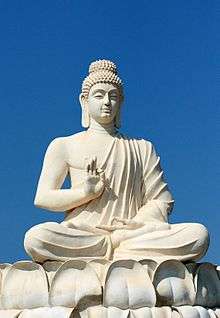
The corresponding Western Gregorian calendar dates varies from year to year:
East Asia
In many East Asian countries Buddha's Birth is celebrated on the 8th day of the 4th month in the Chinese lunar calendar (in Japan since 1873 on April 8 of the Gregorian calendar), and the day is an official holiday in Hong Kong, Macau and South Korea. The date falls from the end of April to the end of May according to the Gregorian calendar.[6]
The primarily solar Gregorian calendar date varies from year to year:
- 2017: May 3
- 2018: May 22
- 2019: May 12
- 2020: April 30
Taiwan
In 1999 the Taiwanese government set Buddha's birthday as the second Sunday of May, the same date as Mother's Day.[7][8]
Japan
As a result of the Meiji Restoration, Japan adopted the Gregorian calendar in lieu of the Chinese lunar calendar in 1873. However, it took approximately until 1945, the end of World War II, for religious festivities to adopt the new calendar. In most Japanese temples, Buddha's birth is now celebrated on the Gregorian and buddhist calendar date April 8; only a few (mainly in Okinawa) celebrate it on the orthodox Chinese calendar date of the eighth day of the fourth lunar month.[9]
Celebrations in each country
Asia
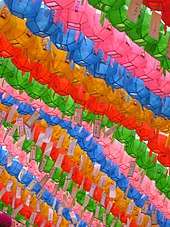
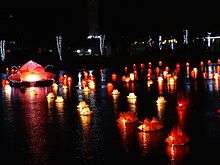
Bangladesh
In Bangladesh, the event is called বুদ্ধ পূর্ণিমা or Buddho Purnima. On the days preceding Purnima, Buddhist monks and priests decorate Buddhist temples with colourful decorations and candles. On the day of the festival, the President and Prime Minister deliver speeches addressing the history and importance of Buddhism, and of religious harmony in the country. From noon onwards large fairs are held in and around the temples and viharas, selling bengali food (largely vegetarian), clothes, and toys. Performances of Buddha's life are also presented. Buddhist monks teach celebrants about the Dharma and the Five Precepts (panchashila). Buddhists then attend a congression inside the monastery where the chief monk delivers a speech discussing the Buddha and the Three Jewels (tri-ratna), and about living the ideal life. Afterwards, a prayer to the Buddha is offered, and people then light candles and recite the Three Jewels and Five Precepts.[10][11]
Cambodia
In Cambodia, Buddha's Birthday is celebrated as Visak Bochea and is a public holiday where monks around the country carry the Buddhist flag, lotus flowers, incense, and candles to acknowledge Vesak. People also take part in alms-giving to the monks.[12]
China
In China, celebrations may occur in Buddhist temples where people may light incense and bring food offerings for the monks.[13] In Hong Kong, Buddha's birthday is a public holiday. Lanterns are lit to symbolise the Buddha's enlightenment and many people visit the temple to pay their respects. The bathing of statues of the Buddha is a major feature of Buddha's birthday celebrations in the city.[14] The festival is also a public holiday in Macau.[15]
India
The public holiday for Buddha purnima in India was initiated by B. R. Ambedkar when he was the minister of law and justice.[16] It is celebrated especially in Sikkim, Ladakh, Arunachal Pradesh, Bodh Gaya, various parts of North Bengal such as Kalimpong, Darjeeling, and Kurseong, and Maharashtra (where 77% of total Indian Buddhists live), as well as other parts of India as per Indian calendar. Buddhists go to common Viharas to observe a rather longer-than-usual, full-length Buddhist sutra, akin to a service. The dress code is pure white. Non-vegetarian food is normally avoided. Kheer, sweet rice porridge is commonly served to recall the story of Sujata, a maiden who, in Gautama Buddha's life, offered the Buddha a bowl of milk porridge. Informally called "Buddha's Birthday," it actually commemorates the birth, enlightenment (nirvāna), and death (Parinirvāna) of Gautama Buddha in the Theravada tradition. Tibetans in exile remember Buddha's birthday on the 7th day of the Saga Dawa month (fourth month of the Tibetan calendar), which culminates with Buddha's parinirvana celebrations on the full moon day.
Indonesia
In Indonesia, Buddha's Birthday is celebrated as Waisak and is a public holiday. A large procession beginning in Mendut in Java, and ends at Borobudur – the largest Buddhist temple in the world.[17][18]
Japan
In Japan, Buddha's Birthday is known as Kanbutsu-e (Japanese: 灌仏会) or Hanamatsuri (Flower Festival) (Japanese: 花祭り) and is held on April 8. Buddha's birth is also celebrated according to the Buddhist calendar but is not a national holiday. On this day, all temples hold 降誕会 (Gōtan-e), 仏生会 (Busshō-e), 浴仏会 (Yokubutsu-e), 龍華会 (Ryūge-e) and 花会式 (Hana-eshiki). Japanese people pour ama-cha (a beverage prepared from hydrangea serrata, a variety of hydrangea) on small Buddha statues decorated with flowers, as if bathing a newborn baby. The tradition of bathing the Buddha originated in China and was introduced to Japan where it was first held in Nara in 606.[19] Lion dancing is also a major tradition practiced during Buddha's Birthday and has become associated with the festival in Japan.[20]
Malaysia
In Malaysia, Buddha's Birthday is celebrated as Wesak Day and is a public holiday celebrated by the sizeable minority Buddhist population in the country. Temples across the country are decorated, and caged animals are set free. People engage in prayers, chanting, and alms-giving across the country.[12]
Mongolia
In Mongolia, Buddha's Birthday is celebrated as Ikh Duichen and its date is determined by the Mongolian lunar calendar.[21] As a result, the date falls in line with celebrations of Buddha's Birthday/Vesak in South and Southeast Asian countries as opposed to neighbouring East Asian countries.[22] In December 2019, the popularly celebrated festival by many Mongolian Buddhists, is made a public holiday. [23]
Myanmar
In Myanmar, Buddha's Birthday is celebrated as Full Moon of Kason and is a public holiday. It is celebrated by watering the Bodhi tree and chanting. In large pagodas, music and dance is also performed as part of the celebrations.[12]
Nepal
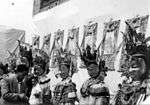
In Nepal, the birthplace of Buddha, his birthday is celebrated on the full moon day of May. The festival is known by various names, Buddha Jayanti, Buddha Purnima, Vaishakh Purnima, Saga Dawa, and Vesak. Purnima means full moon day in Sanskrit. Among the Newars of Nepal, especially from the Shakya clan of Newars, it is of great importance because they consider it as a continuation of the sage of the Śākyas- the clan that Lord Buddha's family belonged to. Thus, they celebrate the festival which is in their language known as Swānyā Punhi (स्वांया पुन्हि), the full moon day of flowers.[24] The day marks not just the birth of Shakyamuni Gautama Buddha, but also the day of his Enlightenment and Mahaparinirvana.
The event is celebrated by gentle and serene fervour, keeping in mind the very nature of Buddhism. People, especially women, go to common Viharas to observe a rather longer-than-usual, full-length Buddhist sutra, something like a service. The usual dress is pure white. Non-vegetarian food is normally avoided. Kheer, sweet rice porridge is commonly served to recall the story of Sujata, a maiden who offered the Buddha a bowl of milk porridge.
Buddha Purnima is the biggest day for Buddhists because on this day, it is believed three important events of the Buddha's life took place: his birth, his attaining enlightenment, and his death, Paranirvana. This day is known as Thrice Blessed Festival.[25]
North Korea
Buddha's Birthday is occasionally designated as a public holiday in North Korea and is known as Chopail (Korean: 초파일).[26] Designation of traditional Korean holidays as public holidays in North Korea are determined by the Cabinet a few days before the traditional holiday begins.[26] Buddha's Birthday is a traditional festival in Korean culture, and was celebrated in Korea long before the division of the country. As a result, the festival is still celebrated in North Korea by the country's Buddhist population.[27]
Singapore
In Singapore, Buddha's birthday is celebrated as Vesak or Vesak Day and is a public holiday in the country. Buddhist temples hold celebrations and are decorated with Buddhist flags and flowers. Devotees also bring offerings to the temples.[28]
South Korea
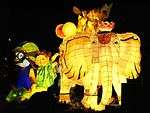
In South Korea, the birthday of Buddha is celebrated according to the Korean lunar calendar and is a public holiday. This day is called 석가탄신일 (Seokga tansinil), meaning "Buddha's birthday" or 부처님 오신 날 (Bucheonim osin nal) meaning "the day when the Buddha came." Lotus lanterns hang in temples throughout the month and lanterns are hung in homes and in the streets.[29] On the day of Buddha's birth, many temples provide free meals and tea to all visitors. Breakfast and lunch are also provided, which often includes sanchae bibimbap. Buddha's Birthday is a popular holiday and folk celebration in Korea, and is often celebrated by people of all religious faiths.[29]
Sri Lanka
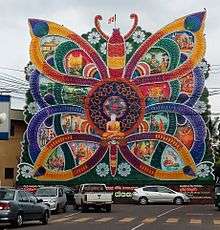
In Sri Lanka, Buddha's Birthday is celebrated as Vesak and is a public holiday celebrated on the first full moon day of the month of May. Its date is determined by the Buddhist lunar calendar. People engage in religious observances and decorate houses and streets with candles and paper lanterns as well as bamboo-framed lanterns. Dansalas is practised and refers to the free offering of food and drink to people. Devotional songs known as Bakthi Gee are sung, and decorative gateways calledpandols are erected throughout the country. Temples around the country also hold celebrations, and devotees bring offerings and burn incense.[30] Electric light displays that depict stories from the Buddha's life are also a notable part of Vesak celebrations in the country.[31]
Taiwan
In Taiwan, Buddha's birthday is a national holiday. Devotees pour fragrant water over Buddha statues to symbolise the beginning of a fresh start in life.[32]
Thailand
In Thailand, Buddha's birthday is celebrated as Visakha Puja and is a public holiday. People gather at temples to hear sermons, give donations and chant prayers.[33]
Vietnam
Buddha's birthday is celebrated throughout Vietnam. Many Buddhist temples hold celebrations that attract people from around the country, while pagodas around the country are decorated.[34] From 1958 to 1975, Lễ Phật Đản, the birthday of Buddha (on the 8th day of the 4th month in the Lunar calendar) was recognized as a national public holiday in South Vietnam,[35] enjoyed with floats and lantern parades on the streets.
Festivities outside Asia
Australia
In Sydney, Buddha's birthday is celebrated at the Nan Tien Temple in Wollongong, while another celebration also organised by Nan Tien Temple is held at Darling Harbour, which features Buddha's birthday ceremony. A variety of vegetarian food is served, and culture stalls and multicultural performances are held, celebrating cultures from China, Japan, Vietnam, Korea, India, Malaysia, Sri Lanka, Australia.[36][37] Other temples in the Fo Guang Shan Nan Tien Temple group in Australia also hld celebrations on the eighth day of the fourth month of the China lunar calendar.[38] In Brisbane, the Buddha's Birthday Festival is held annually and features a variety of pan-Asian food, and performances from various cultures are held.[39] It is a weekend-long festival which draws over 200 000 visitors.[40] In Melbourne, the weekend-long festival called Buddha's Day and Multicultural Festival is held at Federation Square around April/May.[41] In Perth, a two-day celebration also known as Buddha's Day and Multicultural Festival is held at Langley Park.[42] Local Buddhist temples and smaller towns around the country such as Bendigo, Victoria also hold celebrations.[43]
On the Australian external territory of Christmas Island, Buddha's Birthday is celebrated as "Vesak Day" and is celebrated alongside many other celebrations common in Australia and Malaysia as well as local celebrations of the island.[44][45]
Brazil
Vesak (Hanamatsuri) is widely known and celebrated in Brazil due to the country's large Japanese community. Hanamatsuri has grown in popularity and also attracts interest from the wider non-Japanese Brazilian population. As a result, Hanamatsuri has become a consumerist culture phenomenon in the country and is sometimes locally known as Festa das Flores.[46][47] Hanamatsuri is celebrated in the São Paulo neighbourhood of Liberdade which is home to the largest Japanese community outside of Japan.[48] Hanamatsuri celebrations in Liberdade began in 1966 and includes a parade on Galvão Bueno street. Celebrations are also held at the suburb's major shopping centre, Liberdade Plaza.[47][48]
Canada
In Toronto, three Buddhist temples representing the three main branches of Buddhism organize an annual event known as Vesak: Buddha's Birthday.[49] It is held at Mississauga Celebration Square, and features a number of Buddhist-themed events and activities, as well as cultural acts from Asia, including China, Sri Lanka and Vietnam.[50][51][52]
United States of America
The celebration of Buddha's Birthday in the United States differs from community to community, depending on ethnicity and nationality.
The Japanese celebration on 8 April has been significant in the Bay Area of California for some decades. In 1968 the first circumambulation of Mt. Tamalpais to celebrate Buddha's Birthday was conducted. Starting in 1969 at Tassajara Zen Mountain Center, Hana-Matsuri was celebrated each spring. Dressed in formal black robes, the roughly 70 monks and students form a formal procession to the Horse Pasture with the leader periodically ringing a small, clear bell. A temporary stone altar was built under a huge oak tree in a gorgeous field of green grass and abundant wildflowers; a small statue of a baby Buddha was placed upon it in a metal basin. Then each person, in turn, approaches the altar, and ladle one thin-lipped bamboo dipperful of sweet green tea over the statue, bow, and walk to one side.[53]
In New York, the International Lotus Lantern Parade has been a notable and successful annual event held at Union Square Park. The event celebrates the Buddha's birthday and Yeon Deung Hoe (연등회), a Korean lantern celebration that is held during Vesak. The festival features a number of Buddhist themed events and is started off by numerous Buddhist centres of Japanese, Korean and Sri Lankan origins for example.[54]
Since 1963, the state of Hawaii has recognized April 8 of each year as "Buddha Day", which celebrates the birth of Siddhartha Gautama, the founder of Buddhism.
See also
- List of Buddhist festivals
- List of festivals in Asia
- Public holidays in Nepal
- Public holidays in India
- Public holidays in Hong Kong
- Bun Festival - a festival held on the same day in Hong Kong.
- Public holidays in Macau
- Public holidays in North Korea
- Public holidays in South Korea
- Holidays in Taiwan
- Holidays of Japan
- Public holidays in Bangladesh
- Hanami
- Public holidays in Myanmar
- Holidays in Vietnam
- Public holidays in Thailand
- Public holidays in Sri Lanka
- Public holidays in Bhutan
- Public holidays in Singapore
- Public holidays in Indonesia
- Vesak
References
- National Holidays, Official site of Korea Tourism
- UNESCO, Lumbini in Nepal is the birthplace of the Lord Buddha, Gethin Foundations, p. 19, which states that in the mid-3rd century BCE the Emperor Ashoka determined that Lumbini was Gautama's birthplace and thus installed a pillar there with the inscription: "... this is where the Buddha, sage of the Śākyas (Śākyamuni), was born."
- For instance, Gethin Foundations, p. 14, states: "The earliest Buddhist sources state that the future Buddha was born Siddhārtha Gautama (Pali Siddhattha Gotama), the son of a local chieftain—a rājan—in Kapilavastu (Pali Kapilavatthu) what is now the Indian–Nepalese border." However, Professor Gombrich (Theravāda Buddhism, p. 1) and the old but specialized study by Edward Thomas, The Life of the Buddha, ascribe the name Siattha/fitta to later sources.
- https://www.officeholidays.com/religious/buddhist/buddhas_birthday.php
- "BUDDHA PURNIMA (Vesak Day) 2020: Family Life of Gautam Buddha". SA News Channel.
- "Why the full moon day in May is so auspicious in Buddhism". Scroll.
- Camaron Kao (14 May 2012), "Thousands of believers mark Buddha's birthday", China Post, archived from the original on 16 June 2013
- Ko Shu-Ling (9 May 2011), "Sakyamuni Buddha birthday celebrated", Taipei Times,
The legislature approved a proposal in 1999 to designate the birthday of Sakyamuni Buddha — which falls on the eighth day of the fourth month of the lunar calendar — a national holiday and to celebrate the special occasion concurrently with International Mother’s Day, which is celebrated on the second Sunday of May.
- "Buddhist countries and different names of Buddha Purnima". Indian express.
- "বুদ্ধ পূর্ণিমা", সিলেবাসে নেই, দৈনিক কালের কণ্ঠ; ১১ মে ২০১১ খ্রিস্টাব্দ। পৃ. ৪। পরিদর্শনের তারিখ: ১৭ মে ২০১১ খ্রিস্টাব্দ।
- http://m.ntvbd.com/religion-and-life/129443/আজ-শুভ-বুদ্ধ-পূর্ণিমা
- "Archived copy". Archived from the original on 11 March 2016. Retrieved 11 March 2016.CS1 maint: archived copy as title (link)
- http://buddhism.about.com/od/buddhistholidays/ig/Images-of-Vesak/Buddhas-BDay-China.htm#step-heading
- http://www.hong-kong-traveller.com/buddha-birthday.html#.VuJye_l94dU
- https://publicholidays.asia/macau/buddhas-birthday/
- http://www.officeholidays.com/countries/india/
- https://www.justlanded.com/english/Indonesia/Indonesia-Guide/Culture/Vesak-festival-in-Indonesia
- http://www.ibtimes.co.uk/indonesia-vesak-day-buddhas-birthday-borobudur-worlds-biggest-buddhist-temple-photos-1504198
- https://www.meetup.com/pl-PL/buddhism-613/events/59639372/?_cookie-check=q6MkUIbiHx5eZP04
- Hulsbosch, Marianne; Bedford, Elizabeth; Chaiklin, Martha (2009). Asian Material Culture. ISBN 9789089640901.
- https://www.eternal-landscapes.co.uk/buddhas-birthday-celebrations-ulaanbaatar/
- http://www.buddhistchannel.tv/index.php?id=25,1239,0,0,1,0
- https://gogo.mn/r/xkvvv
- Dunipace, Sujal Jane (May 2003). "Nepal's Buddha Jayanti Celebration". ECS Nepal. Archived from the original on 18 December 2011. Retrieved 9 May 2013.
- "Buddha Purnima".
- Understanding North Korea: Totalitarian dictatorship, Highly centralized economies, Grand Socialist Family. 길잡이미디어. 2015. p. 385.
- Encyclopedia of Korean Seasonal Customs: Encyclopedia of Korean Folklore and Traditional Culture Vol. 1. 길잡이미디어. 2014. p. 147. ISBN 978-8992128926.
- http://publicholidays.sg/vesak-day/
- Encyclopedia of Korean Seasonal Customs: Encyclopedia of Korean Folklore and Traditional Culture Vol. 1. 길잡이미디어. 2014. p. 150. ISBN 978-8992128926.
- https://www.lanka.com/events/vesak-festival/
- "Archived copy". Archived from the original on 11 March 2016. Retrieved 11 March 2016.CS1 maint: archived copy as title (link)
- https://huffingtonpost.com/2012/05/05/vesak-how-buddhas-birthda_n_1478896.html
- http://buddhism.about.com/od/buddhistholidays/ig/Images-of-Vesak/Visak-Puja-Thailand.htm
- http://goseasia.about.com/od/eventsfes6/tp/vn_festivals.01.htm
- Niên biểu lịch sử Phật giáo Việt Nam Archived 15 November 2012 at the Wayback Machine
- http://www.nantien.org.au/en/events/buddhas-birthday-festival
- http://blog.apc.edu.au/2013/05/buddhas-birthday-celebration.html
- "Buddha's Birthday Education Project". International Buddhist Progress Society. Retrieved 12 January 2014.
- http://www.buddhabirthdayfestival.com.au/
- "Buddha Birthday Festival". Buddha's Light International Association, Chung Tian Temple. Archived from the original on 26 January 2014. Retrieved 26 January 2014.
- "Buddha's Birthday and Multicultural Festival". Buddha's Light International Association Victoria. Retrieved 31 March 2014.
- "Archived copy". Archived from the original on 14 March 2016. Retrieved 2016-03-06.CS1 maint: archived copy as title (link)
- http://www.bendigotourism.com/whats-on/whats-on-this-month/event/3258-vesak-festival-of-light
- "Archived copy" (PDF). Archived from the original (PDF) on 5 March 2016. Retrieved 11 March 2016.CS1 maint: archived copy as title (link)
- "Archived copy". Archived from the original on 15 October 2015. Retrieved 21 October 2015.CS1 maint: archived copy as title (link)
- Dessi, Ugo (1 July 2016). The Global Repositioning of Japanese Religions: An integrated approach. ISBN 9781317030126.
- Negawa, Sachio (11 October 2007). "Chapter 8: The Formation and Development of Bairro Oriental (3) - The Emergence of a New "Tradition"". Discover Nikkei. Retrieved 17 February 2018.
- "Hanamatsuri". CulturaJaponesa.com.br. Retrieved 17 February 2018.
- http://www.vesakcelebration.com/
- "Archived copy". Archived from the original on 8 March 2016. Retrieved 8 March 2016.CS1 maint: archived copy as title (link)
- http://www.mississauga.com/news-story/4518929-buddhists-to-mark-buddha-s-birthday-at-celebration-square/
- https://culture.mississauga.ca/event/celebration-square/vesak-buddha%E2%80%99s-birthday-celebration
- http://www.japanese-city.com/calendar/events/index.php?eID=32066
- http://interfaithcenter.org/archives/5318
Further reading
- The Folkloric Study of Chopail (Buddha's Birthday), written by Prof. M.Y.Pyeon. Produced by Minsokwon in Seoul Korea 2002.
External links
| Wikimedia Commons has media related to Buddha's Birthday. |
- Buddha Jayanti About Buddha Jayanti
- Buddha's Birthday बुद्ध जयन्ती Buddha's Birthday बुद्ध जयन्ती
